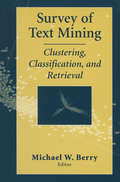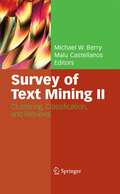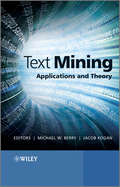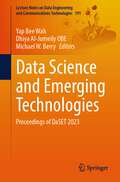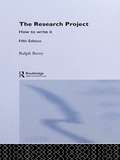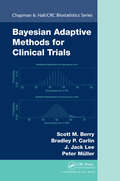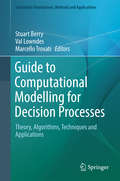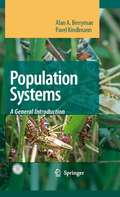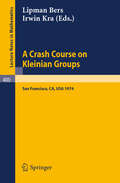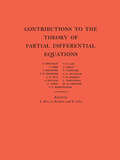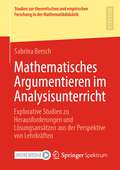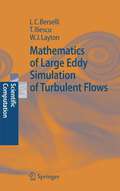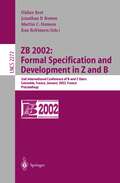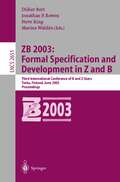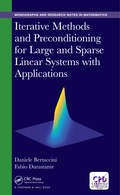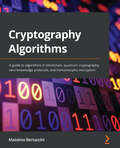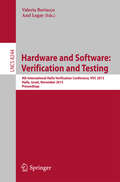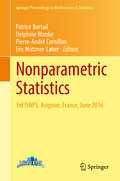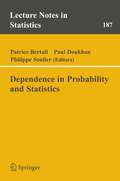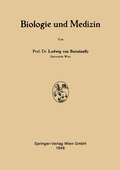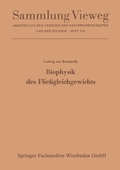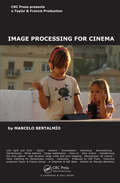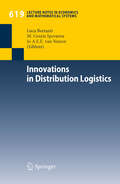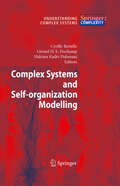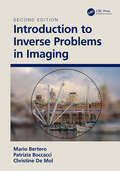- Table View
- List View
Survey of Text Mining: Clustering, Classification, and Retrieval
by Michael W. BerryExtracting content from text continues to be an important research problem for information processing and management. Approaches to capture the semantics of text-based document collections may be based on Bayesian models, probability theory, vector space models, statistical models, or even graph theory. As the volume of digitized textual media continues to grow, so does the need for designing robust, scalable indexing and search strategies (software) to meet a variety of user needs. Knowledge extraction or creation from text requires systematic yet reliable processing that can be codified and adapted for changing needs and environments. This book will draw upon experts in both academia and industry to recommend practical approaches to the purification, indexing, and mining of textual information. It will address document identification, clustering and categorizing documents, cleaning text, and visualizing semantic models of text.
Survey of Text Mining II: Clustering, Classification, and Retrieval
by Michael W. Berry Malu CastellanosThis Second Edition brings readers thoroughly up to date with the emerging field of text mining, the application of techniques of machine learning in conjunction with natural language processing, information extraction, and algebraic/mathematical approaches to computational information retrieval. The book explores a broad range of issues, ranging from the development of new learning approaches to the parallelization of existing algorithms. Authors highlight open research questions in document categorization, clustering, and trend detection. In addition, the book describes new application problems in areas such as email surveillance and anomaly detection.
Text Mining: Applications and Theory
by Michael W. Berry Jacob KoganText Mining: Applications and Theory presents the state-of-the-art algorithms for text mining from both the academic and industrial perspectives. The contributors span several countries and scientific domains: universities, industrial corporations, and government laboratories, and demonstrate the use of techniques from machine learning, knowledge discovery, natural language processing and information retrieval to design computational models for automated text analysis and mining. This volume demonstrates how advancements in the fields of applied mathematics, computer science, machine learning, and natural language processing can collectively capture, classify, and interpret words and their contexts. As suggested in the preface, text mining is needed when “words are not enough.” This book: Provides state-of-the-art algorithms and techniques for critical tasks in text mining applications, such as clustering, classification, anomaly and trend detection, and stream analysis. Presents a survey of text visualization techniques and looks at the multilingual text classification problem. Discusses the issue of cybercrime associated with chatrooms. Features advances in visual analytics and machine learning along with illustrative examples. Is accompanied by a supporting website featuring datasets. Applied mathematicians, statisticians, practitioners and students in computer science, bioinformatics and engineering will find this book extremely useful.
Data Science and Emerging Technologies: Proceedings of DaSET 2023 (Lecture Notes on Data Engineering and Communications Technologies #191)
by Michael W. Berry Yap Bee Wah Dhiya Al-Jumeily OBEThe book presents selected papers from International Conference on Data Science and Emerging Technologies (DaSET 2023), held online at UNITAR International University, Malaysia during December 4–5, 2023. This book presents current research and applications of data science and emerging technologies. The topics covered are artificial intelligence, big data technology, machine and deep learning, data mining, optimization algorithms, blockchain, Internet of Things (IoT), cloud computing, computer vision, cybersecurity, augmented and virtual reality, cryptography, and statistical learning.
The Research Project: How to Write It (6th edition)
by Ralph BerryNow in its fifth edition, this guide to project work continues to be an indispensable resource for all students undertaking research. Guiding the reader right through from preliminary stages to completion, The Research Project: How to write it sets out in clear and concise terms the main tasks involved in doing a research project, covering: * choosing a topic * using the library effectively * taking notes * shaping and composing the project * providing footnotes, documentation and a bibliography * avoiding common pitfalls. Fully updated throughout, this new edition features a chapter on making the most out of the Internet, from knowing where to start, to assessing the quality of the material found there. Other features include a model example of a well researched, clearly written paper with notes and bibliography and a chapter on getting published in a learned journal for more advanced researchers. Whether starting out or experienced in research, The Research Project: How to write it is an essential tool for success. Now in its fifth edition, this guide to project work continues to be an indispensable resource for all students undertaking research. Guiding the reader right through from preliminary stages to completion, The Research Project: How to write it sets out in clear and concise terms the main tasks involved in doing a research project, covering: * choosing a topic * using the library effectively * taking notes * shaping and composing the project * providing footnotes, documentation and a bibliography * avoiding common pitfalls. Fully updated throughout, this new edition features a chapter on making the most out of the Internet, from knowing where to start, to assessing the quality of the material found there. Other features include a model example of a well researched, clearly written paper with notes and bibliography and a chapter on getting published in a learned journal for more advanced researchers. Whether starting out or experienced in research, The Research Project: How to write it is an essential tool for success.
Bayesian Adaptive Methods for Clinical Trials
by Scott M. Berry Bradley P. Carlin J. Jack Lee Peter MullerAlready popular in the analysis of medical device trials, adaptive Bayesian designs are increasingly being used in drug development for a wide variety of diseases and conditions, from Alzheimer's disease and multiple sclerosis to obesity, diabetes, hepatitis C, and HIV. Written by leading pioneers of Bayesian clinical trial designs, Bayesian Adapti
Guide to Computational Modelling for Decision Processes: Theory, Algorithms, Techniques and Applications (Simulation Foundations, Methods and Applications)
by Stuart Berry Val Lowndes Marcello TrovatiThis interdisciplinary reference and guide provides an introduction to modeling methodologies and models which form the starting point for deriving efficient and effective solution techniques, and presents a series of case studies that demonstrate how heuristic and analytical approaches may be used to solve large and complex problems. Topics and features: introduces the key modeling methods and tools, including heuristic and mathematical programming-based models, and queueing theory and simulation techniques; demonstrates the use of heuristic methods to not only solve complex decision-making problems, but also to derive a simpler solution technique; presents case studies on a broad range of applications that make use of techniques from genetic algorithms and fuzzy logic, tabu search, and queueing theory; reviews examples incorporating system dynamics modeling, cellular automata and agent-based simulations, and the use of big data; supplies expanded descriptions and examples in the appendices.
Population Systems: A General Introduction
by Alan A. Berryman Pavel KindlmannThis unique book is concerned with the general principles and theories of population ecology, based on the idea that the rules governing the dynamics of populations are relatively simple, and that the rich behavior we observe in nature is a consequence of the structure of the system rather than of the complexity of the underlying rules. From this perspective, the dynamic behavior of single-species populations is examined and an elementary feedback model of the population system is developed. This single-species model is refined and generalized by examining the mechanisms of population regulation.
A Crash Course on Kleinian Groups: Lectures given at a special session at the January 1974 meeting of the American Mathematical Society at San Francisco (Lecture Notes in Mathematics #400)
by L. Bers I. KraContributions to the Theory of Partial Differential Equations. (AM-33), Volume 33 (PDF)
by Lipman Bers Salomon Bochner Fritz JohnThe description for this book, Contributions to the Theory of Partial Differential Equations. (AM-33), Volume 33, will be forthcoming.
Mathematisches Argumentieren im Analysisunterricht: Explorative Studien zu Herausforderungen und Lösungsansätzen aus der Perspektive von Lehrkräften (Studien zur theoretischen und empirischen Forschung in der Mathematikdidaktik)
by Sabrina BerschSabrina Bersch untersucht in zwei aufeinander aufbauenden qualitativen Studien das mathematische Argumentieren im Analysisunterricht aus der Perspektive von Lehrkräften. Zunächst werden die Begriffe Argumentieren, Begründen und Beweisen geklärt und in einem Modell zueinander in Beziehung gesetzt. Das mathematische Argumentieren wird dabei im weiten Sinne als Oberbegriff verstanden. Die erste Interviewstudie thematisiert unter anderem die aktuelle Situation des mathematischen Argumentierens im Analysisunterricht. Es zeigt sich insbesondere, dass die Heterogenität von Lerngruppen sowie sprachliche Schwierigkeiten von Schülerinnen und Schülern zentrale Herausforderungen für Lehrkräfte sind. Als Reaktion darauf werden weitere theoretische Grundlagen geklärt und eine differenzierende, aufgabenbasierte Lernumgebung mit sprachförderlichen Elementen zum Argumentieren mit ganzrationalen Funktionen ausgearbeitet. Hierfür werden verschiedene Aufgaben, Lösungsbeispiele und Formulierungshilfen entwickelt. Der unterrichtliche Einsatz dieser Lernumgebung durch Lehrkräfte wird mit einer anschließenden, zweiten Studie evaluiert.
Mathematics of Large Eddy Simulation of Turbulent Flows (Scientific Computation)
by Luigi Carlo Berselli Traian Iliescu William J. LaytonThe LES-method is rapidly developing in many practical applications in engineering The mathematical background is presented here for the first time in book form by one of the leaders in the field
ZB 2002: 2nd International Conference of B and Z Users Grenoble, France, January 23-25, 2002, Proceedings (Lecture Notes in Computer Science #2272)
by Didier Bert Jonathan P. Bowen Martin C. Henson Ken RobinsonZB 2003: Third International Conference of B and Z Users, Turku, Finland, June 4-6, 2003, Proceedings (Lecture Notes in Computer Science #2651)
by Didier Bert Jonathan P. Bowen Steve King Marina WaldénThe refereed proceedings of the Third International Conference of Z and B Users, ZB 2003, held in Turku, Finland in June 2003. The 28 revised full papers presented together with 3 invited papers were carefully reviewed and selected for inclusion in the book. The book documents the recent advances for the Z formal specification notation and for the B method, spanning the full scope from foundational, theoretical, and methodological issues to advanced applications, tools, and case studies.
Iterative Methods and Preconditioning for Large and Sparse Linear Systems with Applications (Chapman & Hall/CRC Monographs and Research Notes in Mathematics)
by Daniele Bertaccini Fabio DurastanteThis book describes, in a basic way, the most useful and effective iterative solvers and appropriate preconditioning techniques for some of the most important classes of large and sparse linear systems. The solution of large and sparse linear systems is the most time-consuming part for most of the scientific computing simulations. Indeed, mathematical models become more and more accurate by including a greater volume of data, but this requires the solution of larger and harder algebraic systems. In recent years, research has focused on the efficient solution of large sparse and/or structured systems generated by the discretization of numerical models by using iterative solvers.
Cryptography Algorithms (PDF): A Guide to Algorithms in Blockchain, Quantum Cryptography, Zero-knowledge and Homomorphic Encryption
by Massimo BertacciniBuild your real-world cryptography knowledge, from understanding the fundamentals to implementing the most popular modern-day algorithms to excel in your cybersecurity career Key Features Learn modern algorithms such as zero-knowledge, elliptic curves, and quantum cryptography Explore vulnerability and new logical attacks on the most-used algorithms Understand the practical implementation of algorithms and protocols in cybersecurity applications Book Description Cryptography Algorithms is designed to help you get up and running with modern cryptography algorithms. You'll not only explore old and modern security practices but also discover practical examples of implementing them effectively. The book starts with an overview of cryptography, exploring key concepts including popular classical symmetric and asymmetric algorithms, protocol standards, and more. You'll also cover everything from building crypto codes to breaking them. In addition to this, the book will help you to understand the difference between various types of digital signatures. As you advance, you will become well-versed with the new-age cryptography algorithms and protocols such as public and private key cryptography, zero-knowledge protocols, elliptic curves, quantum cryptography, and homomorphic encryption. Finally, you'll be able to apply the knowledge you've gained with the help of practical examples and use cases. By the end of this cryptography book, you will be well-versed with modern cryptography and be able to effectively apply it to security applications. What you will learn Understand key cryptography concepts, algorithms, protocols, and standards Break some of the most popular cryptographic algorithms Build and implement algorithms efficiently Gain insights into new methods of attack on RSA and asymmetric encryption Explore new schemes and protocols for blockchain and cryptocurrency Discover pioneering quantum cryptography algorithms Perform attacks on zero-knowledge protocol and elliptic curves Explore new algorithms invented by the author in the field of asymmetric, zero-knowledge, and cryptocurrency Who this book is for This hands-on cryptography book is for IT professionals, cybersecurity enthusiasts, or anyone who wants to develop their skills in modern cryptography and build a successful cybersecurity career. Working knowledge of beginner-level algebra and finite fields theory is required. Table of Contents Deep Diving into Cryptography Introduction to Symmetric Encryption Asymmetric Encryption Introducing Hash Functions and Digital Signatures Introduction to Zero-Knowledge Protocols New Algorithms in Public/Private Key Cryptography Elliptic Curves Quantum Cryptography Crypto Search Engine
Hardware and Software: 9th International Haifa Verification Conference, HVC 2013, Haifa, Israel, November 5-7, 2013, Proceedings (Lecture Notes in Computer Science #8244)
by Valeria Bertacco Axel LegayThis book constitutes the refereed proceedings of the 9th International Haifa Verification Conference, HVC 2013, held in Haifa, Israel in November 2013. The 24 revised full papers presented were carefully reviewed and selected from 49 submissions. The papers are organized in topical sections on SAT and SMT-based verification, software testing, supporting dynamic verification, specification and coverage, abstraction and model presentation.
Nonparametric Statistics: 3rd ISNPS, Avignon, France, June 2016 (Springer Proceedings in Mathematics & Statistics #250)
by Patrice Bertail Delphine Blanke Pierre-André Cornillon Eric Matzner-LøberThis volume presents the latest advances and trends in nonparametric statistics, and gathers selected and peer-reviewed contributions from the 3rd Conference of the International Society for Nonparametric Statistics (ISNPS), held in Avignon, France on June 11-16, 2016. It covers a broad range of nonparametric statistical methods, from density estimation, survey sampling, resampling methods, kernel methods and extreme values, to statistical learning and classification, both in the standard i.i.d. case and for dependent data, including big data. The International Society for Nonparametric Statistics is uniquely global, and its international conferences are intended to foster the exchange of ideas and the latest advances among researchers from around the world, in cooperation with established statistical societies such as the Institute of Mathematical Statistics, the Bernoulli Society and the International Statistical Institute. The 3rd ISNPS conference in Avignon attracted more than 400 researchers from around the globe, and contributed to the further development and dissemination of nonparametric statistics knowledge.
Dependence in Probability and Statistics (Lecture Notes in Statistics #187)
by Patrice Bertail Paul Doukhan Philippe SoulierThis book gives an account of recent developments in the field of probability and statistics for dependent data. It covers a wide range of topics from Markov chain theory and weak dependence with an emphasis on some recent developments on dynamical systems, to strong dependence in times series and random fields. There is a section on statistical estimation problems and specific applications. The book is written as a succession of papers by field specialists, alternating general surveys, mostly at a level accessible to graduate students in probability and statistics, and more general research papers mainly suitable to researchers in the field.
Biophysik des Fließgleichgewichts: Einführung in die Physik offener Systeme und ihre Anwendung in der Biologie (Sammlung Vieweg)
by Ludwig BertalanffyImage Processing for Cinema
by Marcelo BertalmioImage Processing for Cinema presents a detailed overview of image processing techniques that are used in practice in digital cinema. The book shows how image processing has become ubiquitous in movie-making, from shooting to exhibition. It covers all the ways in which image processing algorithms are used to enhance, restore, adapt, and convert movi
Innovations in Distribution Logistics (Lecture Notes in Economics and Mathematical Systems #619)
by Luca Bertazzi M. Grazia Speranza Jo Van NunenIn a globalized economy logistics has become a crucial area for the success of companies. The performance of each company depends on the performance of its suppliers and of its business partners. The customers of each company are spread on a large geographical space. For this reason distribution logistics is the most important and complex part of logistics. An efficient and effective management of distribution logistics is a key issue for the success of a company. There are many different problems to deal with, from facility location to transportation, to inventory management, and, most important, to the integration and optimization of the entire logistics network. Quantitative methods provide relevant tools to support decisions, from strategic to operational, in distribution logistics.
Complex Systems and Self-organization Modelling (Understanding Complex Systems)
by Cyrille Bertelle Gérard H. E. Duchamp Hakima Kadri-DahmaniIntroduction to Inverse Problems in Imaging
by M. Bertero P. Boccacci Christine De MolFully updated throughout and with several new chapters, this second edition of Introduction to Inverse Problems in Imaging guides advanced undergraduate and graduate students in physics, computer science, mathematics and engineering through the principles of linear inverse problems, in addition to methods of their approximate solution and their practical applications in imaging. This second edition contains new chapters on edge-preserving and sparsity-enforcing regularization in addition to maximum likelihood methods and Bayesian regularization for Poisson data. The level of mathematical treatment is kept as low as possible to make the book suitable for a wide range of students from different backgrounds, with readers needing just a rudimentary understanding of analysis, geometry, linear algebra, probability theory, and Fourier analysis. The authors concentrate on presenting easily implementable and fast solution algorithms, and this second edition is accompanied by numerical examples throughout. It will provide readers with the appropriate background needed for a clear understanding of the essence of inverse problems (ill-posedness and its cure) and, consequently, for an intelligent assessment of the rapidly growing literature on these problems. Key features: Provides an accessible introduction to the topic while keeping mathematics to a minimum Interdisciplinary topic with growing relevance and wide-ranging applications Accompanied by numerical examples throughout
